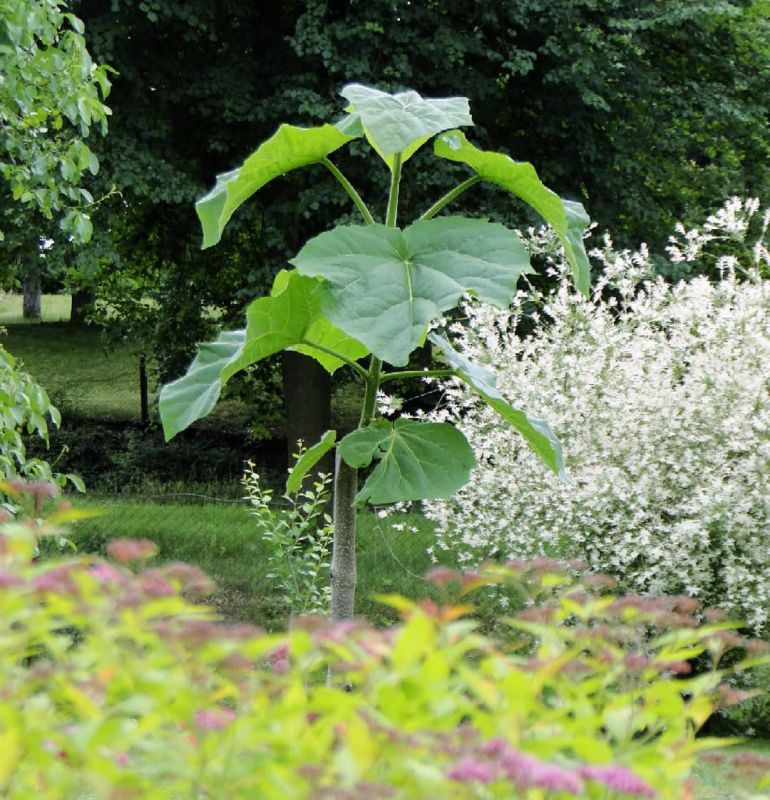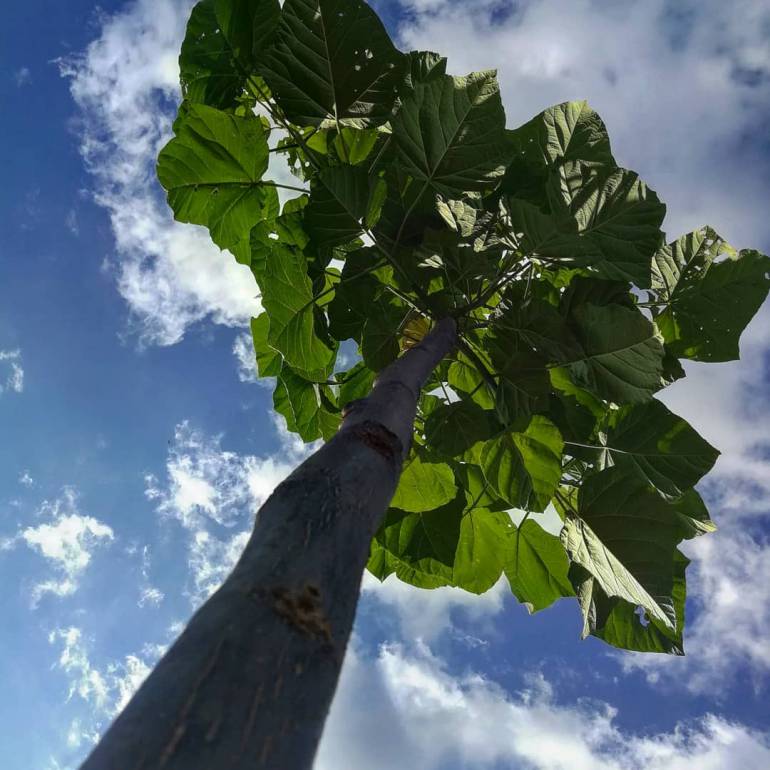Perhaps in a crevasse in a parking lot or near the side of a stream or road you saw some tall weeds with thick stalks, and you are wondering what the plant could be. While weeds can be hard to identify, there are relatively few invasive kinds of weeds that are really tall.
If you live in the Eastern half of the U.S., and especially if you didn’t notice the plants the year before and now they are suddenly several feet tall with large heart-shaped leaves, then you are probably seeing a Paulownia Tree Sapling.

This weed grows quickly, being classified as a weed due to its invasiveness, yet it is technically a tree. It has flowers of different colors and can put on quite a display.
However, if you are seeing some tall weeds with thick stalks and yellow flowers, then it is likely not the Paulownia since they do not flower in their first year nor do they have a variety that grows yellow flowers.
How To Identify Paulownia Plants
Paulownia trees can also be referred to sometimes as Princess Trees, Empress Trees, or even Foxglove Trees and their flowers can sometimes resemble those of Foxgloves.
Unlike Foxgloves, however, Paulownia trees only come in a limited number of varieties with only a couple different colors of flowers, one color being blue with yellow flowers with the other having more lavender or pink flowers that sometimes are so light as to look like white flowers.

Royal Paulownia Tree Flowers
The flowers are a couple of inches in size or smaller and bloom for only 2-4 weeks out of the year, usually around April or May, and then they produce egg-shaped seed pods.
These seed pods eventually turn brown in color and contain seeds in four different sections. Late in the winter or early in spring before it starts growing, the seed pods will crack open and release thousands of seeds. A large tree can potentially release several million seeds each year.
What Are Some Of The Benefits Of Paulownia Plants

Paulownia trees are excellent shade trees, growing up to fifteen feet in their first year and then their growth slows as they continue to grow to around thirty to forty feet in height. For that reason, they can be found in many garden magazines.
Their blue and yellow flowers and their purplish pink flowers are lovely to behold each spring, and it is entirely self-sufficient, not even needing the occasional watering or mulching.
The wood from this plant is excellent for woodworking with very little chance that it will warp or split, no matter what the moisture it is exposed to is.
In some places in China, it used to be a custom to plant one of these trees when a family had a baby daughter born. When the daughter was old enough to marry they would cut it down and use the wood to make items for her dowry.
Why And How To Get Rid Of Paulownia Plants
Paulownia trees are incredibly invasive and grow wild as far north as Maine, as far south as Florida, and as far east as Texas with one or two other states in the far north-east having some as well.
It grows so quickly that it can kill out other native plants and it is considered so harmful to the ecosystem that it is actually illegal to sell this plant in Connecticut.
Getting rid of Paulownia trees can be extremely difficult to do since these plants grow so well. The first step to getting rid of these weeds is to prevent them from spreading more seeds and increasing their population. You can do this most effectively by cutting the tree near the roots every year.
Since paulownia trees can only flower on mature growth, this prevents them from flowering and thereby prevents them from having any seeds, though it doesn’t kill the plant.
Small sproutlings can be pulled up by hand, preferably right after a good rain, so the soil is loose. Be careful to get all pieces of the root because paulownia weeds can grow back again if you leave so much as a sliver of the root behind. For this same reason, girdling the tree will have little effect as the part of the tree beneath the girdle will quickly grow off-shoots and sprouts.
Girdling the tree, cutting it above the girdle, and immediately applying a stump remover or herbicide to the top, has a good amount of success at killing these Paulownia trees.
Seedlings that are too large to pull up by hand can sometimes be killed by spraying the leaves with herbicides like RoundUp. If you dislike using chemicals, it is possible to kill it by repeatedly cutting it to the ground a few times a year for a couple of years or so.
- How to Get Rid of Wood Mites - September 24, 2020
- Can You Have Stained Doors With Painted Trim? - May 27, 2020
- Is Duct Tape Flammable? and Other Burning Questions About Duct Tape - April 2, 2020


Cas
Monday 17th of August 2020
Ok, i was getting real excited since the plant I had looks and sounds like what you described. However, the plant I have has yellow leaves and I really need to know what it is so if you ever see this comment please help.
Carol
Friday 26th of August 2022
@Cas, It sounds like it might be what they call velvetleaf. They are a nuisance and take away a lot of nutrition from your other plants. In fact, what I found identified it as a noxious weed. I found one in my vegetable garden. Thought it was just a different type of flowering plant so left it until I could identify it. Pulled it as soon as I found out what it was.
Type: Broadleaf annual
Size: Up to 6 feet tall and 3 feet wide
Where It Grows: Fertile, sunny landscape and garden areas
Appearance: Velvetleaf gets its name because of its large, velvety heart-shape leaves up to 10 inches across. The weed blooms with yellow flowers in summer.